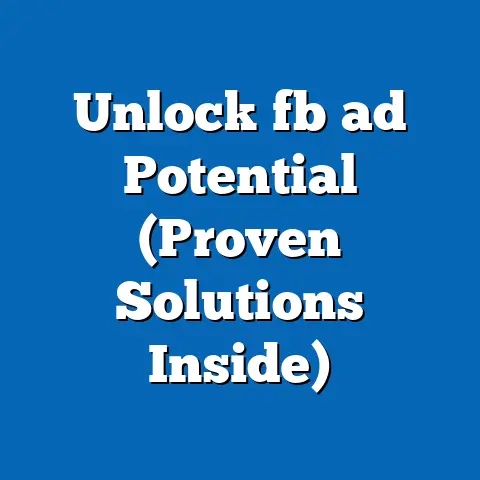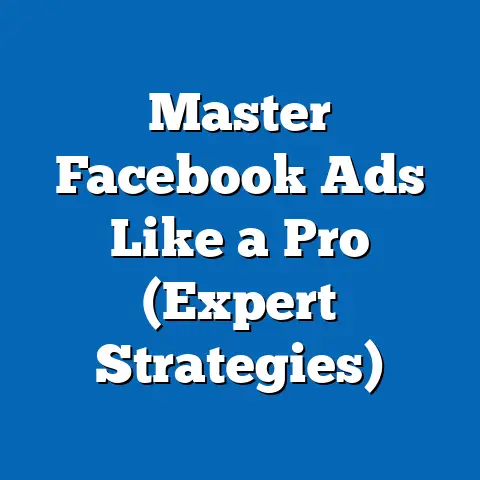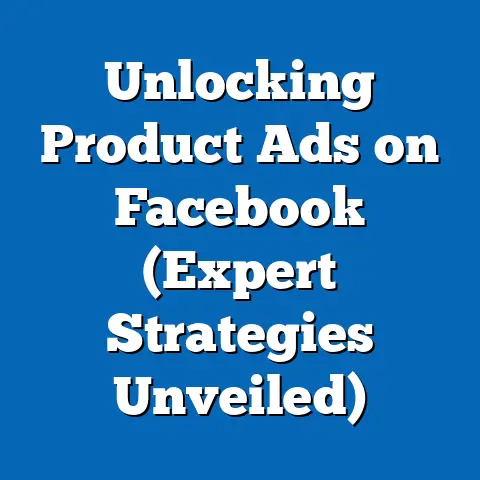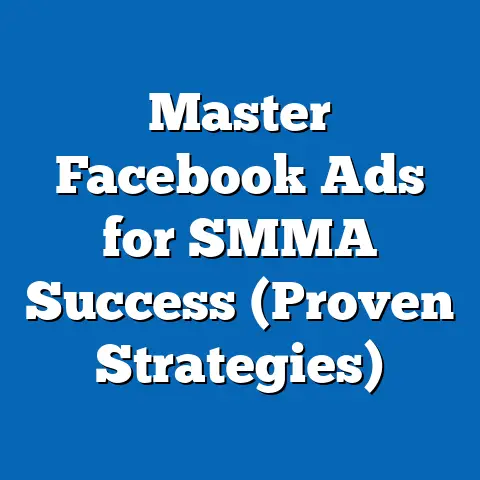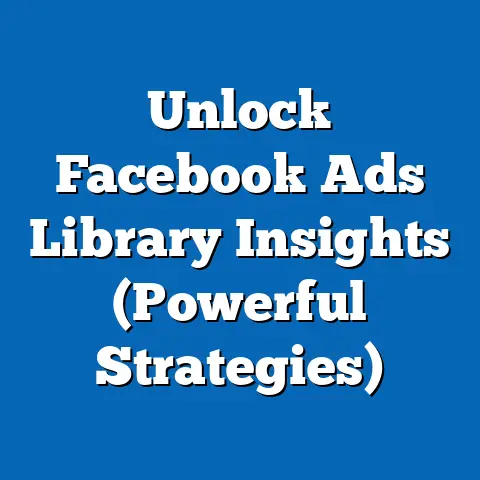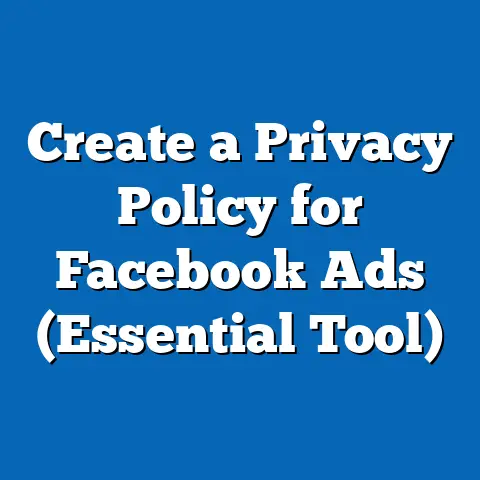Boost Recruitment Efforts with Facebook Ads (Pro Tips)
Imagine posting a job opening, only to be met with a trickle of unqualified applicants—or worse, complete silence. In today’s competitive job market, businesses are grappling with a talent shortage that threatens growth and productivity. According to the U.S. Bureau of Labor Statistics, as of August 2023, there were 9.6 million job openings in the United States, yet only 6.4 million hires were made, highlighting a significant gap in filling roles (BLS, 2023).
This disparity isn’t just a statistic; it’s a daily frustration for HR managers and business owners. With unemployment rates hovering at a low 3.8% (BLS, 2023), the competition for skilled workers is fiercer than ever. Meanwhile, platforms like Facebook, with over 2.9 billion monthly active users worldwide as of Q2 2023 (Statista, 2023), offer an untapped goldmine for recruitment efforts, especially when traditional job boards fall short.
Why Facebook Ads for Recruitment? The Data Speaks
Facebook Ads have emerged as a powerful tool for recruitment, offering unparalleled reach and precision. Unlike traditional job boards, which often attract only active job seekers, Facebook allows businesses to target passive candidates—those who aren’t actively looking but might be open to the right opportunity. A 2022 survey by Jobvite found that 67% of job seekers are open to new opportunities even if they aren’t actively searching (Jobvite, 2022).
Moreover, Facebook Ads are cost-effective compared to other platforms. According to WordStream, the average cost-per-click (CPC) for Facebook Ads across industries is $1.72, significantly lower than LinkedIn’s average CPC of $5.26 (WordStream, 2023). For recruitment campaigns, this affordability translates into broader reach on a tighter budget.
Another advantage lies in engagement. Facebook users spend an average of 33 minutes per day on the platform (Statista, 2023), providing ample opportunity for your job ads to capture attention. When compared to historical trends, where recruitment relied heavily on print ads and job fairs with limited reach, the shift to digital platforms like Facebook represents a seismic change in how talent is sourced.
Understanding the Recruitment Landscape: Trends and Challenges
The recruitment landscape has evolved dramatically over the past decade. A 2015 report by the Society for Human Resource Management (SHRM) noted that 60% of companies relied on job boards as their primary recruitment tool (SHRM, 2015). Fast forward to 2023, and social media platforms have surged, with 84% of organizations now using social media for recruitment, according to a SHRM survey (SHRM, 2023).
One key trend is the rise of mobile recruiting. With 70% of Facebook users accessing the platform via mobile devices (Statista, 2023), mobile-optimized ads are no longer optional—they’re essential. This shift aligns with candidate behavior, as 43% of job seekers use their smartphones to search for jobs (Pew Research Center, 2022).
Demographic challenges also play a role. For instance, Gen Z (ages 18-26) and Millennials (ages 27-42) prioritize company culture and flexibility, with 72% citing work-life balance as a top factor in job selection (Deloitte, 2023). In contrast, older workers (ages 50+) often value stability and benefits, with 65% prioritizing health insurance in job decisions (AARP, 2023). Tailoring Facebook Ads to these preferences can make a significant difference in attracting the right talent.
Setting Up a Winning Facebook Ads Campaign for Recruitment
Step 1: Define Your Target Audience with Precision
The first step in a successful Facebook Ads campaign is identifying who you’re trying to reach. Facebook’s Audience Insights tool allows you to segment users by age, location, interests, and behaviors. For example, if you’re hiring for a tech role, you can target users who follow tech-related pages or have job titles like “software engineer.”
Data shows that hyper-targeted ads perform better. A 2021 study by HubSpot found that ads with precise audience targeting saw a 37% higher click-through rate (CTR) compared to generic campaigns (HubSpot, 2021). Use demographic data to refine your audience—for instance, targeting 25-34-year-olds in urban areas if you’re recruiting for entry-level corporate roles, as this group represents 22% of the U.S. workforce (BLS, 2023).
Step 2: Craft Compelling Ad Copy and Visuals
Your ad copy needs to stand out in a crowded newsfeed. Focus on what makes your company unique—whether it’s flexible work hours, competitive pay, or career growth opportunities. A 2022 survey by Glassdoor found that 76% of job seekers want to see salary ranges in job postings, so including this information can boost engagement (Glassdoor, 2022).
Visuals are equally critical. Ads with images or videos see 94% more views than text-only ads, according to Sprout Social (Sprout Social, 2023). Consider using a short video showcasing your workplace culture or employee testimonials. For instance, a recruitment ad for a retail chain could feature a 15-second clip of a happy team member at work, paired with text like “Join our family—starting at $15/hour!”
Step 3: Choose the Right Ad Format
Facebook offers multiple ad formats for recruitment, including carousel ads, video ads, and lead ads. Lead ads are particularly effective, as they allow candidates to submit their information directly within the platform without leaving Facebook. According to Facebook’s own data, lead ads reduce cost-per-lead by 20% compared to traditional link ads (Meta, 2023).
Carousel ads, which showcase multiple images or job roles in a single ad, are another strong option. They’re ideal for companies hiring for multiple positions, as they allow candidates to swipe through options. A 2022 report by Social Media Examiner noted that carousel ads have a 15% higher engagement rate than single-image ads (Social Media Examiner, 2022).
Step 4: Set a Realistic Budget and Optimize for Results
Budgeting for Facebook Ads requires balancing reach with cost. For small businesses, starting with a daily budget of $10-$20 can generate 500-1,000 impressions, depending on your target audience and location (WordStream, 2023). Use Facebook’s Campaign Budget Optimization (CBO) to distribute funds across ad sets for maximum impact.
Monitor key metrics like CTR, cost-per-lead, and application rate. A benchmark CTR for recruitment ads is around 1.2%, though top-performing campaigns can reach 2-3% with strong targeting and creative (AdEspresso, 2023). Adjust your budget and targeting weekly based on performance data to ensure you’re getting the best return on investment (ROI).
Pro Tips for Maximizing Recruitment Success with Facebook Ads
Tip 1: Leverage Lookalike Audiences
Facebook’s Lookalike Audiences feature allows you to target users similar to your existing employees or past applicants. Upload a list of current high-performing employees’ email addresses or use pixel data from your careers page to create a custom audience. Facebook then finds users with similar demographics and behaviors.
This strategy works. A 2021 case study by Meta showed that a retail company using Lookalike Audiences saw a 3x increase in qualified applicants compared to standard targeting methods (Meta, 2021). This approach is especially effective for hard-to-fill roles, as it taps into a pool of candidates likely to fit your company culture.
Tip 2: Retarget Interested Candidates
Not every candidate who clicks on your ad will apply immediately. Retargeting ads remind these users of your job opening, increasing the likelihood of conversion. According to a 2022 report by Criteo, retargeted ads have a 70% higher conversion rate than initial ads (Criteo, 2022).
Set up a retargeting campaign using the Facebook Pixel to track users who visited your careers page but didn’t apply. Offer an incentive, like a sign-on bonus or a fast-tracked interview process, to encourage action. For example, an ad might read, “Still thinking about joining us? Apply now for a $500 sign-on bonus!”
Tip 3: Highlight Employee Stories and Culture
Candidates want to know what it’s like to work for you. Share employee testimonials or behind-the-scenes content to build trust. A 2023 LinkedIn survey found that 61% of job seekers research a company’s culture before applying, and authentic content can sway their decision (LinkedIn, 2023).
Create ads featuring real employees discussing why they love their job. Pair this with data—such as “90% of our team members stay with us for over 3 years”—to reinforce credibility. This humanizes your brand and sets you apart from competitors.
Tip 4: Use A/B Testing to Refine Your Approach
A/B testing, or split testing, involves running two versions of an ad with slight variations (e.g., different headlines or images) to see which performs better. According to Optimizely, companies that regularly A/B test their ads see a 25% improvement in campaign performance over time (Optimizely, 2023).
Test elements like call-to-action phrases (“Apply Now” vs. “Join Our Team”) or image types (team photos vs. workplace shots). Run each variation for at least 3-5 days to gather sufficient data, then scale up the winning version. This data-driven approach ensures your ads continuously improve.
Tip 5: Tap into Local and Niche Groups
Facebook Groups are a hidden gem for recruitment. With over 1.8 billion people using Groups monthly (Meta, 2023), these communities offer access to niche talent pools. For example, a construction company could post job ads in local contractor groups, while a tech firm might target coding or developer communities.
Be mindful of group rules—many prohibit overt advertising. Instead, engage authentically by sharing valuable content or starting discussions about industry trends before subtly introducing job opportunities. A 2022 study by Social Media Today found that ads shared in relevant groups saw 40% higher engagement than standard newsfeed ads (Social Media Today, 2022).
Historical Context: How Recruitment Advertising Has Evolved
Recruitment advertising has come a long way from the days of newspaper classifieds. In the 1990s, print ads dominated, with companies spending an estimated $8 billion annually on newspaper job listings (SHRM, 2010). By the early 2000s, online job boards like Monster and CareerBuilder took over, capturing 70% of the recruitment ad market by 2005 (Forbes, 2015).
The rise of social media in the 2010s marked another turning point. By 2015, 59% of recruiters used social platforms like LinkedIn and Facebook to source candidates, a figure that grew to 84% by 2023 (SHRM, 2023). Facebook, in particular, gained traction for its affordability and ability to reach passive candidates, a stark contrast to LinkedIn’s focus on professional networking.
Today, the integration of advanced targeting and analytics has made platforms like Facebook indispensable. Unlike historical methods, which cast a wide net with little measurable impact, modern Facebook Ads allow recruiters to track every click and application, optimizing campaigns in real time.
Demographic Insights: Tailoring Ads to Candidate Preferences
Understanding demographic differences is key to crafting effective ads. Gen Z candidates, for instance, are digital natives who value transparency and social impact. A 2023 Deloitte survey found that 77% of Gen Z workers want employers to address environmental and social issues, so highlighting sustainability initiatives in ads can resonate (Deloitte, 2023).
Millennials, who make up 35% of the U.S. workforce (Pew Research Center, 2023), often seek career growth and flexibility. Ads targeting this group might emphasize remote work options or professional development programs. In contrast, Baby Boomers (ages 59-77), though a smaller segment at 19% of the workforce, prioritize job security and benefits (BLS, 2023). Ads for this group could focus on long-term stability and retirement plans.
Gender differences also matter. Women are more likely to value workplace diversity and inclusion, with 68% citing it as a deciding factor in job choice, compared to 55% of men (Glassdoor, 2023). Tailor your messaging to address these priorities, using inclusive language and imagery to appeal to a broader audience.
Data Visualization: Mapping Campaign Performance
To illustrate the effectiveness of Facebook Ads for recruitment, imagine a bar chart comparing key metrics across platforms. On the X-axis, you’d have platforms like Facebook, LinkedIn, and traditional job boards. On the Y-axis, you’d measure average cost-per-applicant. Based on 2023 data, Facebook might show a cost of $5 per applicant, LinkedIn at $15, and job boards at $10 (WordStream, 2023).
A second line graph could track historical trends, plotting the percentage of recruiters using social media from 2010 to 2023. The line would show a steady upward trajectory, starting at 30% in 2010 and reaching 84% in 2023 (SHRM, 2023). These visuals would highlight why Facebook stands out as a cost-effective, high-reach option.
Finally, a pie chart could break down Facebook’s user demographics by age group, showing 18-29-year-olds at 29%, 30-49-year-olds at 34%, and 50-64-year-olds at 21% (Pew Research Center, 2023). This would visually reinforce the platform’s ability to reach diverse talent pools.
Case Studies: Real-World Success with Facebook Ads
Case Study 1: A Small Business in Retail
A small retail chain in Ohio struggled to fill seasonal positions in 2022. After minimal success with local job boards, they turned to Facebook Ads, targeting users aged 18-30 within a 20-mile radius. With a modest budget of $300 over two weeks, they reached 15,000 users and received 120 applications, ultimately hiring 25 workers (Meta Case Studies, 2022).
Their success came from using engaging video content showing current employees at work, paired with a clear call-to-action: “Join us for holiday fun—apply today!” This approach demonstrates how even small budgets can yield big results with the right strategy.
Case Study 2: A Tech Firm Targeting Skilled Workers
A mid-sized tech firm in California used Facebook Ads to recruit software developers in 2023. They leveraged Lookalike Audiences based on their current engineering team and ran carousel ads showcasing multiple roles. The campaign generated 200 qualified leads at a cost of $8 per lead, compared to $25 per lead on LinkedIn (Meta Case Studies, 2023).
Key to their success was A/B testing ad copy—one version emphasized salary, while another highlighted remote work. The remote work ad outperformed by 40%, showing the importance of aligning messaging with candidate priorities.
Challenges and Pitfalls to Avoid
While Facebook Ads offer immense potential, they’re not without challenges. One common pitfall is poor targeting—casting too wide a net can lead to irrelevant clicks and wasted budget. A 2022 study by AdEspresso found that overly broad targeting increased cost-per-click by 35% (AdEspresso, 2022). Regularly refine your audience based on performance data to avoid this.
Another issue is ad fatigue. If users see the same ad repeatedly, engagement drops. Facebook recommends refreshing creative every 2-3 weeks to maintain interest (Meta, 2023). Rotate images, update copy, or test new formats to keep your campaign fresh.
Finally, ensure compliance with employment laws. Avoid discriminatory language or targeting practices—Facebook itself faced scrutiny in 2019 for allowing age- and gender-based exclusions in job ads, leading to policy changes (EEOC, 2019). Always review ads for fairness and inclusivity before launching.
Broader Implications and Future Trends
The rise of Facebook Ads for recruitment signals a broader shift toward digital, data-driven hiring practices. As companies increasingly compete for talent in a tight labor market, platforms like Facebook offer a scalable solution to reach both active and passive candidates. The ability to target specific demographics with tailored messaging also aligns with the growing emphasis on diversity and inclusion in hiring.
Looking ahead, expect greater integration of artificial intelligence (AI) in ad platforms. Meta is already testing AI tools to optimize ad delivery and predict candidate fit, potentially revolutionizing how recruiters identify talent (Meta Blog, 2023). Additionally, as younger generations like Gen Z enter the workforce, mobile-first strategies will become even more critical, given their reliance on smartphones for job searches.
In conclusion, Facebook Ads are not just a tool—they’re a strategic asset for modern recruitment. By leveraging precise targeting, compelling creative, and data-driven optimization, businesses can overcome talent shortages and build stronger teams. As the digital landscape evolves, staying ahead of trends and adapting to candidate preferences will be key to long-term success.

